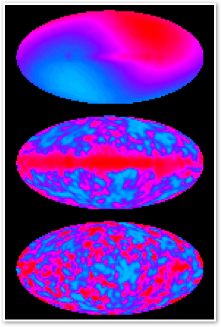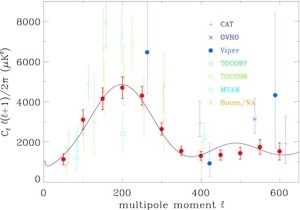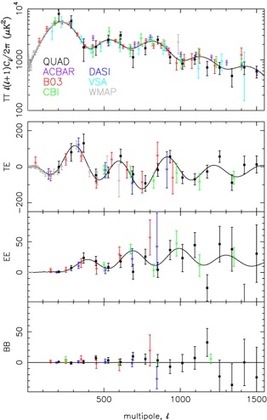CMB Observations

The Cosmic Background Explorer (COBE) was the first space mission dedicated to the CMB. It simultaneously closed and opened two important issues. With regard to the spectrum of the CMB, the COBE measurements demonstrated the precise agreement of the spectrum to a Planck function and placed tight upper limits on spectral distortions. With regard to the spatial dependence of the CMB brightness, COBE measurements were the first to detect anisotropies beyond the dipole variation due to our motion with respect to the CMB. The tremendous success of these measurements, and certainly the opening of the field of observational cosmology through anisotropies of the CMB, garnered the Nobel Prize for physics in 2006 for John Mather and George Smoot. The image shows the sky brightness at 53 to 90 Ghz: the top panel is the total sky brightness, the middle panel has had the dipole subtracted, and the bottom panel has had galactic emission subtracted. The magenta peaks and blue valleys are variations in the CMB brightness at a level of 0.001%. More details on the mission and access to the COBE data products is available from the NASA/Goddard LAMBDA website.

Balloon and space-based measurements in the 1990's made significant advances in our knowledge of the CMB. There is an excellent list of suborbital experiments. The image at right shows an example, combining data from 7 experiments, of measuring the harmoic content of CMB images. The graph shows the amount of power at each multipole, if the image were decomposed into a set of spherical harmonics of order "L". Higher "L" data mean information on finer spatial scales. The observations show that there is a prefereed scale of observable fluctuations: there is significantly more power at "L" around 200, i.e angular scales around 1-2 degrees, than at smaller or larger scales. This peak is called the "first harmonic" and provides a means of constraining the speed of universal expansion.

The Wilkinson Microwave Anisotropy Probe (WMAP) mission has measured the power-spectrum of the CMB with high enough precision that, for low-L, essentially all of the information on the total power of the of the CMB has been extracted. The figure on the right shows the WMAP power spectrum with its very small error bars. In addition to the fundamental harmonic (first peak) of the power spectrum, the next peak is clearly evident.
The polarization of the CMB has only been detected recently. The image at right shows the power spectrum of the polarization of the CMB from Ade et al. (2008). The top panel shows the total power spectrum, while the next one shows the cross-correlation between the polarized and total power spectra. The error bars are clearly not consistent with zero, and some of the harmonic content of this signal is becoming evident. The autocorrelation of the E-mode polarization also shows a significant signal.
